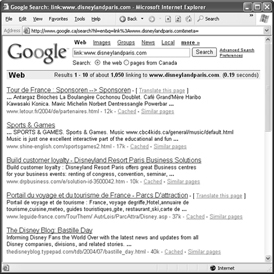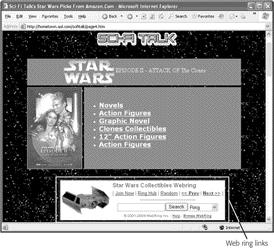Attract Visitors to Your Site: The Mini Missing Manual
Read Attract Visitors to Your Site: The Mini Missing Manual Online
Authors: Matthew MacDonald


Attract Visitors to Your Site: The Mini Missing Manual
by Matthew MacDonald
Copyright © 2010 O’Reilly Media, Inc. All rights reserved.
Published by O’Reilly Media, Inc., 1005 Gravenstein Highway North,
Sebastopol, CA 95472.
O’Reilly Media books may be purchased for educational, business, or sales promotional use. Online editions are also available for most titles: safari.oreilly.com. For more information, contact our corporate/institutional sales department: 800-998-9938 or
[email protected]
.
January 2010: First Edition.
The Missing Manual is a registered trademark of O’Reilly Media, Inc. The Missing Manual logo, and “The book that should have been in the box” are trademarks of O’Reilly Media, Inc. Many of the designations used by manufacturers and sellers to distinguish their products are claimed as trademarks. Where those designations appear in this book, and O’Reilly Media is aware of a trademark claim, the designations are capitalized.
While every precaution has been taken in the preparation of this book, the publisher assumes no responsibility for errors or omissions, or for damages resulting from the use of the information contained in it.
ISBN: 9781449382520
Introduction
A critical part of website success is attracting visitors. This Mini Missing Manual gives you the knowledge and tools you need to do that. It shows you how to build a community around your site and how to use the power of keywords and Web search engines to rise up in the rankings of search results.
Once you do that, you’ll want to see how effective your efforts are. You’ll learn how to use a powerful—and free—service that tracks visitor activity on your site; Google Analytics lets you know where your visitors live, what browser they use, which of your Web pages they love, and—just as important—which pages don’t work for them. Using this information, you can fine-tune your site to keep the visitors coming.
Tip: To learn more about building and improving your website, see
Creating a Web Site: The Missing Manual
.
Attract Visitors
To Your Site
The best website in the world won’t do you much good if it’s sitting out there all by its lonesome self. For your site to flourish, you need to find the best way to attract visitors—and keep them flocking back for more. In this Mini Missing Manual, you’ll learn some valuable tricks for promoting your site. You’ll also see how search engines work, how to make sure they regularly index your site, and how to work your way up the rankings of search results. Lastly, you’ll learn to gauge the success of your site with visitor tracking, and you’ll use a powerful free service called Google Analytics to learn some of your visitors’ deepest secrets (like where they live, what browser they use, and which of your web pages they find absolutely unbearable). Before you know it, you’ll be more popular than chocolate ice cream.
Your Website Promotion Plan
Before you plunge into the world of website promotion, you need a plan. So grab a pencil and plenty of paper, and get ready to jot down your ideas for global website domination (fiendish cackling optional).
Although all webmasters have their own tactics, it’s generally agreed that the best way to market a website is to follow these steps:
1.
Build a truly great website.
If you start promoting your site before there’s anything to see, you’re wasting your effort (and probably burning a few
bridges). Nothing says “never come back” like an empty website with an “under construction” message.
2.
See step 1.
If in doubt, keep polishing and perfecting your site. Fancy graphics aren’t the key concern here—the most important detail is whether you have some genuinely useful content. Ask yourself—if you were browsing the Web, would you stop to take a look at this site? Make sure you’ve taken the time to add the kinds of content that keep visitors coming back.
3.
Share links with friends and like-minded sites.
This step is all about building community. Contrary to what you might expect, this sort of small-scale, word-of-mouth promotion might bring more traffic to your site than high-powered search engines like Google.
4.
Perfect your site’s meta elements.
Meta elements contain hidden words that convey important information about your site’s content, like a site description. Search engines use them as one way to determine what your website’s all about. For details, see below.
5.
Submit your website to Internet directories.
Like search engines, directories help visitors find websites. The difference between directories and search engines is that directories are generally smaller catalogs put together by humans, rather than huge sprawling text indexes amassed by computers.
6.
Submit your website to Internet search engines.
Now you’re ready for the big time. Once you submit your website to web heavyweights like Google and Yahoo, it officially enters the public eye. However, it takes time to climb up the rankings and get spotted.
7.
Figure out what happened.
To assess the successes and failures of your strategy, you need to measure some vital statistics—how many people visit your site, how long they’re staying, and how many visitors come back for more. To take stock, you need to crack open tools like hit counters and server logs.
Throughout this book, you’ll tackle these steps, get some new ideas, and build up a collection of promotion strategies.
Spreading the Word
Some of the most effective promotion you can do doesn’t involve any high-tech XHTML wonkery, but instead amounts to variations on the theme of good old-fashioned advertising.
The first step is to find other websites like yours. If you create a topic-oriented site—your musings on, say, golf, fine jewelry, or jeweled golf clubs—similar sites make up your virtual neighborhood. They’re part of a larger online community to which you now belong. So why not introduce yourself? Strike up a
reciprocal link
relationship (see the next section).
On the other hand, if you’re creating a business site, similar sites are, obviously, your competitors. As a result, you’re unlikely to share links. However, it’s a great idea to Google your competition. You’ll probably find service sites—business directories, news sites, content sites, and so on—that link to these competitors. Once you find these service sites, you can publicize your site there as well.
Reciprocal Links
A reciprocal link is a link-trading agreement. The concept is simple. You find a website with similar content and strike a bargain: Link to my site, and I’ll link to yours. Reciprocal links are an important thread in the underlying fabric of the Web. If you’re not sure where to start searching for potential link buddies, pay a visit to Google and use the
link
: operator (as explained in
Figure 1-1
) to see who’s linking to sites similar to yours. (You can get an even more powerful link viewer as part of the Google Webmaster Tools, described in
“Google AdWords”
, below.)
Reciprocal links only work if there’s a logical connection between the two sites. For example, if you create the website
http://www.ChocolateSculptures.com/
, it probably makes sense to exchange links with
http://www.101ChocolateRecipes.com/
. But
http://www.HomerSimpsonForPresident.com/
is a far stretch, no matter how much traffic it gets.
Topic isn’t the only consideration in link exchanges. You should also look for sites that
feel
professional. If a similarly themed site is choked with ads, barren of content, formatted with fuchsia text on a black background, and was last updated circa 1998, keep
looking.
Once you find a site you want to exchange links with, dig around on the site for the webmaster’s email address. Send a message explaining that you love
http://www.101ChocolateRecipes.com/
, and plan to link to it from your site,
http://www.ChocolateSculptures.com/
. Then, gently suggest that you think your website would be of great interest to
http://www.101ChocolateRecipes.com/
readers.
Tip: Reciprocal linking can require a little finesse. It’s best to look for sites that complement yours, but don’t necessarily compete with it. You’ll also have more luck if you approach web peers, sites of similar quality or with a similar amount of traffic to yours.

Figure 1-1:
Google has a little-known but valuable search keyword that identifies sites that link to your site (or anyone else’s for that matter). It’s the link: operator. If you type in
link:http://www.disneylandparis.com/
,
for example, you see all the sites that link to EuroDisney’s home page. You can use any URL you want (for example, try
link:http://www.disneylandparis.com/uk/introduction.htm/
to find out who’s linking to the English-language intro page).
Once you enter into a link agreement—even if it’s just an informal exchange of emails—remember to keep your end of the deal. Don’t remove the link from your site without letting the other webmaster know about the change. It’s also a good idea to keep checking on the other site to make sure your link remains prominent. If it disappears, don’t fly into an Othellian rage—just send a polite email asking where it went or why it disappeared.
Reciprocal links are also a good way to start working your way up search engine rankings (see
“Rising up in the rankings”
below). That’s because one of the criteria Google takes into account when it determines how to order the results of a web search is how many other sites link to yours. The more popular you are, the more likely you’ll climb up the list.
Note: There are some companies that sell reciprocal link services. The basic idea is that they try to pair up different websites (for a fee) in a link-sharing agreement. Don’t fall for it. Your traffic might increase, but the visitors you get won’t really be interested in the content of your site, and they won’t hang around for long.
Web Rings
A web ring is similar to a reciprocal link, but instead of sharing a link between two partners, it binds a
group
of websites together.
For example, imagine you create a brilliant new site featuring reality TV trivia. To get more exposure, you can join a web ring dedicated to reality TV. You agree to put a block of XHTML on your site that advertises the ring and lets your visitors go to other sites in it. As payback, you become another stop within the ring (see
Figure 1-2
).
Sadly, the majority of web rings consist of gaudy, amateurish Web disasters. Pair up with these nightmares and your site will be deemed guilty by association. However, with a little research, you may find a higher-quality ring. Maybe. To search for one, use Google (enter the topic followed by the words “web ring”).
Note: The biggest disadvantage to Web rings is that they usually require you to add a fairly ugly set of links to your page. Before you sign up, carefully evaluate whether the extra traffic is worth it, and travel to all the other sites in the ring to see if they’re of similar quality. If you’re in a ring with low-quality sites, it can hurt your reputation.
Shameless Self-Promotion
To get your website listed on many of the Web’s most popular sites, you need to fork over some cold, hard cash. However, some of the best advertising doesn’t cost anything. The trick is to look for sites where you can promote
and
contribute at the same time.
For example, if you create the website
http://www.HotComputerTricks.com/
, why not answer a few questions on a computing newsgroup or discussion board? It’s considered tactless to openly promote your site, but there’s nothing wrong with dispensing some handy advice and following it up with a signature that includes your URL.
Here’s an example of how you can answer a poster’s question and put in a good word for yourself at the same time:
Jim,
The problem is that most hard drives will fail when submerged in water. Hence, your fishing computer idea won’t work.
Sasha Mednick
http://www.HotComputerTricks.com/
An answer posting is much better than sending an email directly to the original poster because on a popular site hundreds of computer aficionados with the same question will read your posting. If even a few decide to check out your site, you’ve made great progress.
If you’re very careful, you might even get away with something that’s a little more explicit:
Jim,
The problem is that most hard drives will fail when submerged in water. Hence, your fishing computer idea won’t work. However, you might want to check out my homemade hard-drive vacuum enclosure (
http://www.HotComputerTricks.com/
), which I developed to solve the same problem.
Sasha Mednick
http://www.HotComputerTricks.com/
Warning: This maneuver requires a very light touch. The rule of thumb is that your message should be well-intentioned. Only direct someone to your site if there really is something specific there that addresses the question.
